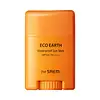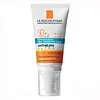The Saem Eco Earth Waterproof Sun Stick SPF 50+ PA++++ Versus La Roche-Posay Anthelios Ultra Facial Sunscreen SPF 50+
What's inside
What's inside
 Key Ingredients
Key Ingredients

 Benefits
Benefits

 Concerns
Concerns

 Ingredients Side-by-side
Ingredients Side-by-side

Synthetic Wax
AbrasiveCaprylic/Capric Triglyceride
MaskingC12-15 Alkyl Benzoate
AntimicrobialSilica
AbrasiveHomosalate
Skin ConditioningDiethylamino Hydroxybenzoyl Hexyl Benzoate
UV FilterButylene Glycol Dicaprylate/Dicaprate
EmollientVinyl Dimethicone/Methicone Silsesquioxane Crosspolymer
Bis-Ethylhexyloxyphenol Methoxyphenyl Triazine
Skin ConditioningEthylhexyl Salicylate
UV AbsorberButyloctyl Salicylate
Skin ConditioningSilica Silylate
EmollientOctocrylene
UV AbsorberCetyl Alcohol
EmollientPoly C10-30 Alkyl Acrylate
Emulsion StabilisingDipropylene Glycol
HumectantGlycerin
HumectantWater
Skin ConditioningEpilobium Angustifolium Extract
Skin ConditioningHydrolyzed Acacia Macrostachya Seed Extract
Skin ConditioningLepidium Meyenii Root Extract
Skin ConditioningMoringa Oleifera Seed Oil
EmollientMaltodextrin
AbsorbentEchium Plantagineum Seed Oil
Skin ConditioningMadecassoside
AntioxidantCentella Asiatica Extract
CleansingAloe Barbadensis Leaf Extract
EmollientDioscorea Japonica Root Extract
Skin ConditioningLaminaria Japonica Extract
Skin ProtectingUlmus Davidiana Root Extract
Skin ConditioningViola Mandshurica Flower Extract
AntioxidantGlycyrrhiza Uralensis Extract
EmollientCnidium Monnieri Fruit Extract
HumectantCentella Asiatica Leaf Extract
Skin ConditioningSolidago Virgaurea Extract
Skin ConditioningRosmarinus Officinalis Leaf Extract
AntimicrobialAdenosine
Skin ConditioningCaprylic/Capric Glycerides
EmollientSorbitan Sesquioleate
EmulsifyingTocopheryl Acetate
AntioxidantPolyglyceryl-10 Oleate
Skin ConditioningHydrogenated Lecithin
EmulsifyingOctyldodecanol
EmollientOctyldodecyl Oleate
EmollientOctyldodecyl Stearoyl Stearate
EmollientButylene Glycol
HumectantAlcohol Denat.
AntimicrobialEthylhexylglycerin
Skin Conditioning1,2-Hexanediol
Skin ConditioningParfum
MaskingSynthetic Wax, Caprylic/Capric Triglyceride, C12-15 Alkyl Benzoate, Silica, Homosalate, Diethylamino Hydroxybenzoyl Hexyl Benzoate, Butylene Glycol Dicaprylate/Dicaprate, Vinyl Dimethicone/Methicone Silsesquioxane Crosspolymer, Bis-Ethylhexyloxyphenol Methoxyphenyl Triazine, Ethylhexyl Salicylate, Butyloctyl Salicylate, Silica Silylate, Octocrylene, Cetyl Alcohol, Poly C10-30 Alkyl Acrylate, Dipropylene Glycol, Glycerin, Water, Epilobium Angustifolium Extract, Hydrolyzed Acacia Macrostachya Seed Extract, Lepidium Meyenii Root Extract, Moringa Oleifera Seed Oil, Maltodextrin, Echium Plantagineum Seed Oil, Madecassoside, Centella Asiatica Extract, Aloe Barbadensis Leaf Extract, Dioscorea Japonica Root Extract, Laminaria Japonica Extract, Ulmus Davidiana Root Extract, Viola Mandshurica Flower Extract, Glycyrrhiza Uralensis Extract, Cnidium Monnieri Fruit Extract, Centella Asiatica Leaf Extract, Solidago Virgaurea Extract, Rosmarinus Officinalis Leaf Extract, Adenosine, Caprylic/Capric Glycerides, Sorbitan Sesquioleate, Tocopheryl Acetate, Polyglyceryl-10 Oleate, Hydrogenated Lecithin, Octyldodecanol, Octyldodecyl Oleate, Octyldodecyl Stearoyl Stearate, Butylene Glycol, Alcohol Denat., Ethylhexylglycerin, 1,2-Hexanediol, Parfum
Water
Skin ConditioningDiisopropyl Sebacate
EmollientGlycerin
HumectantBis-Ethylhexyloxyphenol Methoxyphenyl Triazine
Skin ConditioningAlcohol Denat.
AntimicrobialPropanediol
SolventEthylhexyl Salicylate
UV AbsorberEthylhexyl Triazone
UV AbsorberC12-22 Alkyl Acrylate/Hydroxyethylacrylate Copolymer
StabilisingDrometrizole Trisiloxane
UV AbsorberButyl Methoxydibenzoylmethane
UV AbsorberAluminum Starch Octenylsuccinate
AbsorbentSilica
AbrasiveTocopherol
AntioxidantIsopropyl Lauroyl Sarcosinate
Skin ConditioningAcrylates Copolymer
Ammonium Acryloyldimethyltaurate/Vp Copolymer
Caprylyl Glycol
EmollientCitric Acid
BufferingDisodium EDTA
Scutellaria Baicalensis Extract
AntimicrobialT-Butyl Alcohol
PerfumingTerephthalylidene Dicamphor Sulfonic Acid
UV AbsorberTriethanolamine
BufferingXanthan Gum
EmulsifyingWater, Diisopropyl Sebacate, Glycerin, Bis-Ethylhexyloxyphenol Methoxyphenyl Triazine, Alcohol Denat., Propanediol, Ethylhexyl Salicylate, Ethylhexyl Triazone, C12-22 Alkyl Acrylate/Hydroxyethylacrylate Copolymer, Drometrizole Trisiloxane, Butyl Methoxydibenzoylmethane, Aluminum Starch Octenylsuccinate, Silica, Tocopherol, Isopropyl Lauroyl Sarcosinate, Acrylates Copolymer, Ammonium Acryloyldimethyltaurate/Vp Copolymer, Caprylyl Glycol, Citric Acid, Disodium EDTA, Scutellaria Baicalensis Extract, T-Butyl Alcohol, Terephthalylidene Dicamphor Sulfonic Acid, Triethanolamine, Xanthan Gum
 Reviews
Reviews

Ingredients Explained
These ingredients are found in both products.
Ingredients higher up in an ingredient list are typically present in a larger amount.
Alcohol Denat. is an alcohol with a denaturant property. It is created by mixing ethanol with other additives.
This ingredient gets a bad rep because it is irritating and drying - mostly due to its astringent property. Astringents draw out natural oils in tissue, constricting pores and leaving your skin dried out.
However, alcohol denat. is not all that bad.
Due to its low molecular weight, alcohol denat. tends to evaporate quickly. One study on pig skin found half of applied alcohol evaporated in 10 seconds and less than 3% stayed on skin.
This also helps other ingredients become better absorbed upon application.
Studies are conflicted about whether this ingredient causes skin dehydration. One study from 2005 found adding emollients to propanol-based sanitizer decreased skin dryness and irritation. Another study found irritation only occurs if your skin is already damaged.
Small amounts of alcohol are generally tolerated by oily skin or people who live in humid environments.
The rule of thumb is if this alcohol is near the end of an ingredients list, it will probably not affect your skin much.
Also...
This ingredient has antimicrobial and solvent properties.
The antimicrobial property helps preserve products and increase their shelf life. As a solvent, it helps dissolve other ingredients.
Other types of astringent alcohols include:
Learn more about Alcohol Denat.You might know this ingredient as Tinosorb S or Bemotrizinol. It is a UV filter that covers both UVA and UVB rays.
This ingredient has two peak UV absorption peaks ( 310 and 340 nm) and is able to absorb both UV-A and UV-B rays. This ingredient works by preventing UV rays from reaching and damaging your skin.
On top of that - it is highly photostable and helps prevent the photodegration of other sunscreen ingredients such as avobenzone.
Tinosorb S is allowed in the EU, Australia, and Asia. It is close to being approved by the FDA and we'll hopefully get this ingredient in the U.S. by late 2025.
Fun fact: Tinosorb S is the most effective UV absorber at maximum concentration (measured by SPF) permitted in the EU.
This ingredient is oil-soluble, so your oil-cleansers will take this right off at night.
Learn more about Bis-Ethylhexyloxyphenol Methoxyphenyl TriazineEthylhexyl Salicylate is an organic compound used to block UV rays. It primarily absorbs UVB rays but offers a small amount of UVA protection as well.
Commonly found in sunscreens, Ethylhexyl Salicylate is created from salicylic acid and 2-ethylhexanol. You might know salicylic acid as the effective acne fighter ingredient and BHA.
The ethylhexanol in this ingredient is a fatty alcohol and helps hydrate your skin, similar to oils. It is an emollient, which means it traps moisture into the skin.
According to manufacturers, Ethylhexyl Salicylate absorbs UV wavelength of 295-315 nm, with a peak absorption at 307-310 nm. UVA rays are linked to long term skin damage, such as hyperpigmentation. UVB rays emit more energy and are capable of damaging our DNA. UVB rays cause sunburn.
Learn more about Ethylhexyl SalicylateGlycerin is already naturally found in your skin. It helps moisturize and protect your skin.
A study from 2016 found glycerin to be more effective as a humectant than AHAs and hyaluronic acid.
As a humectant, it helps the skin stay hydrated by pulling moisture to your skin. The low molecular weight of glycerin allows it to pull moisture into the deeper layers of your skin.
Hydrated skin improves your skin barrier; Your skin barrier helps protect against irritants and bacteria.
Glycerin has also been found to have antimicrobial and antiviral properties. Due to these properties, glycerin is often used in wound and burn treatments.
In cosmetics, glycerin is usually derived from plants such as soybean or palm. However, it can also be sourced from animals, such as tallow or animal fat.
This ingredient is organic, colorless, odorless, and non-toxic.
Glycerin is the name for this ingredient in American English. British English uses Glycerol/Glycerine.
Learn more about GlycerinSilica, also known as silicon dioxide, is a naturally occurring mineral. It is used as a fine, spherical, and porous powder in cosmetics.
Though it has exfoliant properties, the function of silica varies depending on the product.
The unique structure of silica enhances the spreadability and adds smoothness, making it a great texture enhancer.
It is also used as an active carrier, emulsifier, and mattifier due to its ability to absorb excess oil.
In some products, tiny microneedles called spicules are made from silica or hydrolyzed sponge. When you rub them in, they lightly polish away dead skin layers and enhance the penetration of active ingredients.
Learn more about SilicaWater. It's the most common cosmetic ingredient of all. You'll usually see it at the top of ingredient lists, meaning that it makes up the largest part of the product.
So why is it so popular? Water most often acts as a solvent - this means that it helps dissolve other ingredients into the formulation.
You'll also recognize water as that liquid we all need to stay alive. If you see this, drink a glass of water. Stay hydrated!
Learn more about Water